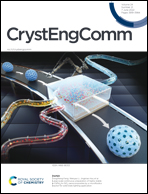Hydrated metal ions as weak Brønsted acids show promoting effects on proton conduction†
Abstract
It is well-known that hydrated metal ions can act as Brønsted acids, which tend to donate protons increasing the acidic proton concentration in materials, as well as the proton conductivity. However, it is challenging to relate proton conductive properties to the contribution to the inherent Lewis acidity of selected metal ions blocked by many factors such as multiple acidic proton sources, inconsistent proton pathways, or extrinsic grain boundaries. Herein, we assemble a metalloligand [CoIII(notpH3)] with Co2+ or Ni2+ ions by solvothermal reactions to obtain three Co–Co phosphonates [CoIICoIII(notpH)(H2O)3]·xH2O (1), [CoIICoIII(notpH)(H2O)]·2H2O (2), and [CoII3CoIII2(notp)2(H2O)12]·2H2O (3), and one Ni–Co phosphonate [NiII3CoIII2(notp)2(H2O)12]·2H2O (4). Layered compounds 3 and 4 are isostructural, and the pentahydrated metal ions MO(H2O)5 (M = Co2+ in 3 and Ni2+ in 4) act as a single proton source in the structures. Their proton conductive properties have been investigated using compacted pellets and single crystals. Co2+ is a slightly stronger Lewis acid than Ni2+, while the conductivities of single crystals of 3 and 4 along the c axis have a 1.5 times difference and are measured to be 1.37 × 10−5 and 8.07 × 10−6 S cm−1 at 25 °C and 95% RH, respectively. This work provides an excellent example of the effect of different hydrated metal ions on proton conduction.



 Please wait while we load your content...
Please wait while we load your content...